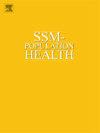到达疫苗接种地点的预期空间可达性与实际旅行时间之间的差异:对COVID-19免疫延迟的影响
IF 3.1
2区 医学
Q1 PUBLIC, ENVIRONMENTAL & OCCUPATIONAL HEALTH
引用次数: 0
摘要
2019冠状病毒病大流行凸显了公平和及时获得疫苗接种的重要性。本研究调查了德克萨斯州纽埃塞斯县到疫苗接种中心的实际和预期旅行时间之间的差异对全面和加强COVID-19疫苗接种及时性的影响。利用来自17.1万名18岁及以上人群的疫苗接种数据,我们采用Cox比例风险模型和生存分析来探讨人口统计学特征、社会脆弱性指数(SVI)和地理差异如何影响疫苗接种延迟。结果显示,超过预期的旅行时间显著降低了及时接种疫苗的可能性(全面接种的HR = 0.95,加强剂量的HR = 0.89)。老年人显示出更高的疫苗接种及时性,但性别、种族和种族之间的差距仍然存在,男性和西班牙裔经历了更大的延迟。相互作用分析突出了老年人和弱势群体在旅行时间差异较大时面临的复杂挑战。这些研究结果强调,迫切需要采取有地理针对性的公共卫生干预措施,以解决卫生危机期间的社会经济差异和改善疫苗可及性。本文章由计算机程序翻译,如有差异,请以英文原文为准。
Disparity between expected spatial accessibility and actual travel time to vaccination sites: Implications for COVID-19 immunization delays
The COVID-19 pandemic underscored the importance of equitable and timely vaccination access. This study examined the impact of discrepancies between actual and expected travel times to vaccination centers on the timeliness of full and booster COVID-19 vaccinations in Nueces County, Texas. Drawing on vaccination data from over 171,000 individuals aged 18 and older, we employed Cox proportional hazards models and survival analysis to explore how demographic characteristics, the Social Vulnerability Index (SVI), and geographic disparities influenced vaccination delays. Results revealed that longer-than-expected travel times significantly reduced the likelihood of timely vaccination (HR = 0.95 for full vaccination, HR = 0.89 for booster doses). Seniors demonstrated higher vaccination timeliness rates, but gaps persisted across gender, ethnicity, and race, with males and Hispanics experiencing greater delays. Interaction analysis highlighted compounded challenges for seniors and vulnerable populations when travel time discrepancies were larger. These findings emphasize the critical need for geographically targeted public health interventions to address socio-economic disparities and improve vaccine accessibility during health crises.
求助全文
通过发布文献求助,成功后即可免费获取论文全文。
去求助
来源期刊

Ssm-Population Health
PUBLIC, ENVIRONMENTAL & OCCUPATIONAL HEALTH-
CiteScore
6.50
自引率
2.10%
发文量
298
审稿时长
101 days
期刊介绍:
SSM - Population Health. The new online only, open access, peer reviewed journal in all areas relating Social Science research to population health. SSM - Population Health shares the same Editors-in Chief and general approach to manuscripts as its sister journal, Social Science & Medicine. The journal takes a broad approach to the field especially welcoming interdisciplinary papers from across the Social Sciences and allied areas. SSM - Population Health offers an alternative outlet for work which might not be considered, or is classed as ''out of scope'' elsewhere, and prioritizes fast peer review and publication to the benefit of authors and readers. The journal welcomes all types of paper from traditional primary research articles, replication studies, short communications, methodological studies, instrument validation, opinion pieces, literature reviews, etc. SSM - Population Health also offers the opportunity to publish special issues or sections to reflect current interest and research in topical or developing areas. The journal fully supports authors wanting to present their research in an innovative fashion though the use of multimedia formats.
 求助内容:
求助内容: 应助结果提醒方式:
应助结果提醒方式:


